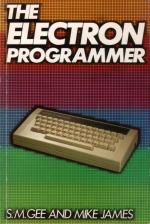
Electron User
 1st January 1984
1st January 1984
Author: Nigel Peters
Publisher: Granada
Machine: Acorn Electron
Published in Electron User 1.04
The launch of a new micro always results in a rush of books about it. The choice can become quite bewildering, and this is especially so in the case of the Acorn Electron as it's so ideally suited for a first time programmer. This means that a lot of people looking for books about it will have no previous experience to help them pick a book to meet their needs.
Because of this, the appearance of The Electron Programmer is doubly welcome. Firstly, it's a good read about an excellent micro and secondly it's a book which I can wholeheartedly recommend for the beginner.
It starts with the usual "What is a micro and how do you set it up?". It then goes on to the inevitable PRINT and LET.
All of this is pretty traditional but then the authors break the mould. They move straight on to a discussion of looping and choice, showing how the flow of control can be affected by the BASIC structures used in a program.
The chapter on procedures and functions follows on from this, then comes a brief but useful section on handling strings and numbers on the micro.
The graphics capabilities of the Electron aren't ignored, nor are its sound facilities. Each aspect is well covered and illustrated with a simple game.
The book finished with a short but well explained treatment of logic and a chapter on better programming.
The style of the book falls between that of the two you found in the box with your new Electron. It's both more readable than the Acorn Electron User Guide (though obviously not as comprehensive) and more adult than the Yazdani tome.
This will make it appeal to those who find the guide a little too technical but don't want to be talked down to.
All the way through, the principles of good programming are illustrated with short but illuminating programs. These are easy to type in and also encourage experimentation. I must warn, however, that there are a couple of typing errors which, although easy to spot, can be a bit confusing for a while.
The authors' aim is to teach complete newcomers how to write well-structured, easy to understand BASIC programs in a logical and coherent manner.
Happily, they don't attempt to produce a rephrased, watered-down user guide but instead concern themselves with teaching the principles of good programming on the Electron.
BASIC keywords and structures are introduced as necessary to illustrate these points, each being explained simply and lucidly.
This is where the book succeeds. Reading it a beginner will not only achieve a reasonably thorough command of Electron BASIC but also have gained insight into the whys and wherefores of good programming.
Well worth considering.


